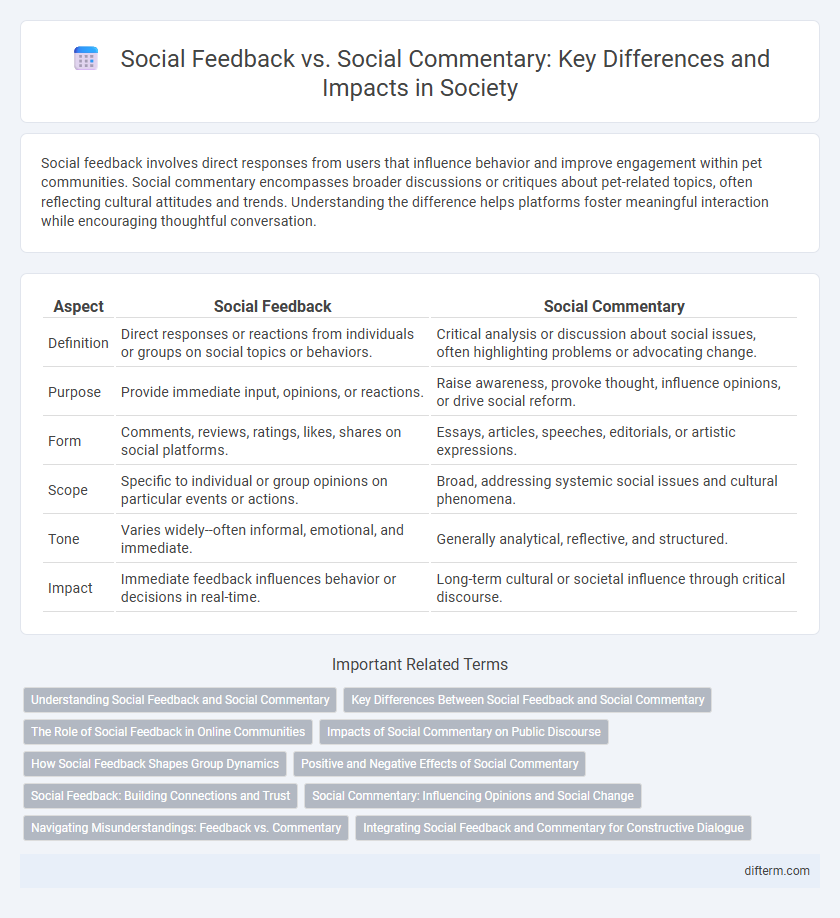Social feedback involves direct responses from users that influence behavior and improve engagement within pet communities. Social commentary encompasses broader discussions or critiques about pet-related topics, often reflecting cultural attitudes and trends. Understanding the difference helps platforms foster meaningful interaction while encouraging thoughtful conversation.
Table of Comparison
| Aspect | Social Feedback | Social Commentary |
|---|---|---|
| Definition | Direct responses or reactions from individuals or groups on social topics or behaviors. | Critical analysis or discussion about social issues, often highlighting problems or advocating change. |
| Purpose | Provide immediate input, opinions, or reactions. | Raise awareness, provoke thought, influence opinions, or drive social reform. |
| Form | Comments, reviews, ratings, likes, shares on social platforms. | Essays, articles, speeches, editorials, or artistic expressions. |
| Scope | Specific to individual or group opinions on particular events or actions. | Broad, addressing systemic social issues and cultural phenomena. |
| Tone | Varies widely--often informal, emotional, and immediate. | Generally analytical, reflective, and structured. |
| Impact | Immediate feedback influences behavior or decisions in real-time. | Long-term cultural or societal influence through critical discourse. |
Understanding Social Feedback and Social Commentary
Social feedback involves direct responses and reactions from individuals within a community, reflecting personal opinions, emotions, and experiences in real-time interactions. Social commentary, on the other hand, offers broader analysis and critique on societal issues, culture, or politics, often delivered through media, art, or literature to provoke thought and dialogue. Understanding the distinction between immediate, personal feedback and analytical, reflective commentary is essential for interpreting public discourse effectively.
Key Differences Between Social Feedback and Social Commentary
Social feedback involves direct responses or reactions from individuals or groups to specific social behaviors or actions, often aiming to influence or improve future conduct, while social commentary provides broader, reflective critiques or analyses of societal trends and issues. Social feedback is typically immediate and interactive, emphasizing real-time engagement, whereas social commentary is more reflective, often articulated through media, literature, or public discourse to provoke thought or awareness. The key difference lies in the purpose and scope: social feedback seeks to guide behavior through immediate input, whereas social commentary aims to stimulate critical discussion and understanding of social phenomena.
The Role of Social Feedback in Online Communities
Social feedback plays a crucial role in shaping user engagement and community dynamics within online platforms by providing immediate recognition and reinforcement of contributions. It fosters a sense of belonging and accountability, encouraging users to share valuable content and participate constructively. The nuanced differences between social feedback, which centers on individual interactions, and social commentary, which addresses broader societal issues, highlight the importance of feedback mechanisms in sustaining active and healthy online communities.
Impacts of Social Commentary on Public Discourse
Social commentary profoundly shapes public discourse by highlighting societal issues and prompting critical reflection among communities. It influences public opinion and can inspire social change by bringing marginalized voices and perspectives into mainstream conversations. As a dynamic force, social commentary fosters awareness, encourages dialogue, and challenges prevailing norms within society.
How Social Feedback Shapes Group Dynamics
Social feedback directly influences group dynamics by reinforcing norms and shaping individual behavior through approval or disapproval signals. This immediate, interactive process fosters cohesion and adaptation within social groups, affecting trust and cooperation levels. In contrast, social commentary offers external reflections that can indirectly modify group perspectives over time but lacks the immediate behavioral impact of social feedback.
Positive and Negative Effects of Social Commentary
Social commentary influences public opinion by highlighting societal issues and encouraging critical thinking, which can lead to positive social change and increased awareness. However, it may also result in polarization, misinformation, or backlash when interpretations differ or when commentary is perceived as biased. The balance between constructive critique and negative impact depends on the accuracy, tone, and context of the social commentary presented.
Social Feedback: Building Connections and Trust
Social feedback fosters authentic connections by encouraging open dialogue and mutual understanding, which strengthens trust within communities. By actively listening and responding to input, individuals and organizations demonstrate empathy and commitment, enhancing relational bonds. This dynamic exchange promotes collaboration and creates a supportive social environment where trust can thrive.
Social Commentary: Influencing Opinions and Social Change
Social commentary serves as a powerful catalyst in shaping public opinion by critiquing societal norms and highlighting issues that demand attention. Through various media, such as literature, film, and online platforms, social commentary exposes injustices and encourages collective reflection and dialogue. This influence often translates into social change by mobilizing communities and policymakers to address and reform systemic problems.
Navigating Misunderstandings: Feedback vs. Commentary
Social feedback involves direct responses aimed at improvement or acknowledgment, while social commentary provides broader observations or critiques on societal issues. Navigating misunderstandings requires recognizing that feedback is often personal and actionable, whereas commentary is interpretive and reflective. Clarifying intentions and context helps prevent confusion between constructive feedback and analytical social commentary.
Integrating Social Feedback and Commentary for Constructive Dialogue
Integrating social feedback and social commentary fosters constructive dialogue by combining real-time audience reactions with in-depth analysis of social issues. Leveraging social feedback enables immediate understanding of public sentiment, while social commentary provides context and critical perspectives that enrich conversations. This synergy promotes more informed, empathetic discussions that drive positive social change.
social feedback vs social commentary Infographic

 difterm.com
difterm.com